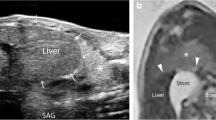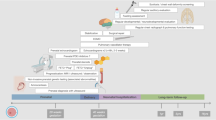Abstract
Purpose
To review the recent Japanese experience with prenatally diagnosed congenital diaphragmatic hernia (CDH) based on a multi-institutional survey.
Methods
A multicenter, retrospective cohort study was conducted on 117 patients born between 2002 and 2007 with isolated prenatally diagnosed CDH. All patients were managed by maternal transport, planned delivery, immediate resuscitation and gentle ventilation. The primary outcome measurements were the 90-day survival and intact discharge. The examined prenatal factors included gestational age (GA) at diagnosis, lung-to-head ratio (LHR), lung-to-thorax transverse area ratio (L/T) and liver position. Physical growth and motor/speech development were evaluated at 1.5 and 3 years of age. Data were expressed as the median (range).
Results
The mean GA at diagnosis was 29 (17–40) weeks. The LHR and L/T were 1.56 (0.37–4.23) and 0.11 (0.04–0.25), respectively. There were 48 patients with liver up. The mean GA at birth was 38 (28–42) weeks. The 90-day survival rate and intact discharge rate were 79 and 63%, respectively. Twelve patients had major morbidity at discharge, and 71% of these patients had physical growth or developmental retardation at 3 years of age.
Conclusion
This multicenter study demonstrated that the 90-day survival rate of isolated prenatally diagnosed CDH was 79%, and that subsequent morbidity remained high. A new treatment strategy is needed to reduce the mortality and morbidity of severe CDH.



Similar content being viewed by others
References
Kays DW, Langham MR, Ledbetter DJ et al (1999) Detrimental effects of standard medical therapy in congenital diaphragmatic hernia. Ann Surg 230:340–351
Logan JW, Cotton CM, Goldberg RN et al (2007) Mechanical ventilation strategies in the management of congenital diaphragmatic hernia. Semin Pediatr Surg 16:115–125
Okuyama H, Kubota A, Oue T et al (2002) Inhaled nitric oxide with early surgery improves the outcome of antenatally diagnosed congenital diaphragmatic hernia. J Pediatr Surg 37:1188–1190
Masumoto K, Teshiba R, Esumi G et al (2009) Improvement in the outcome of patients with antenatally diagnosed congenital diaphragmatic hernia using gentle ventilation and circulatory stabilization. Pediatr Surg Int 25:487–492
Stevens TP, Wijngaarden E, Ackerman KG et al (2009) Timing of delivery and survival rates for infants with prenatal diagnoses of congenital diaphragmatic hernia. Pediatrics 123:494–502
Shehata SM, Tibboel D, Sharma HS et al (1999) Impaired structural remodeling of pulmonary arteries in newborns with congenital diaphragmatic hernia: a histological study of 29 cases. J Pathol 189:112–118
Taira Y, Yamataka T, Miyazaki E et al (1998) Comparison of the pulmonary vasculature in newborns and stillborns with congenital diaphragmatic hernia. Pediatr Surg Int 14:30–35
Frenckner BP, Lally PA, Hintz SR et al (2007) Prenatal diagnosis of congenital diaphragmatic hernia: how should the babies be delivered? J Pediatr Surg 42:1533–1538
Ba’ath ME, Jesudason EC, Losty PD (2007) How useful is the lung-to-head ratio in predicting outcome in the fetus with congenital diaphragmatic hernia? A systematic review and meta-analysis. Ultrasound Obstet Gynecol 30:897–906
Heling KS, Wauer RR, Hammer H et al (2005) Reliability of the lung-to-head ratio in predicting outcome and neonatal ventilation parameters in fetuses with congenital diaphragmatic hernia. Ultrasound Obstet Gynecol 25:112–118
Arkovitz MS, Russo M, Devine P et al (2007) Fetal lung–head ratio is not related to outcome for antenatal diagnosed congenital diaphragmatic hernia. J Pediatr Surg 42:107–110
Jani J, Cannie M, Sonigo P et al (2008) Value of prenatal magnetic resonance imaging in the prediction of postnatal outcome in fetuses with diaphragmatic hernia. Ultrasound Obstet Gynecol 32:793–799
Worley KC, Dashe JS, Barber RG et al (2009) Fetal magnetic resonance imaging in isolated diaphragmatic hernia: volume of herniated liver and neonatal outcome. Am J Obstet Gynecol 200:318.e1–318.e6
Kitano Y, Nakagawa S, Kuroda T et al (2005) Liver position in fetal congenital diaphragmatic hernia retains a prognostic value in the era of lung-protective strategy. J Pediatr Surg 40:1827–1832
Jani J, Nicolaides KH, Keller RL et al (2007) Observed to expected lung area to head circumference ratio in the prediction of survival in fetuses with isolated diaphragmatic hernia. Ultrasound Obstet Gynecol 30:67–71
Usui N, Okuyama H, Sawai T et al (2007) Relationship between L/T ratio and LHR in the prenatal assessment of pulmonary hypoplasia in congenital diaphragmatic hernia. Pediatr Surg Int 23:971–976
Acknowledgments
This work was supported by a grant from The Ministry of Health, Labor and Welfare of Japan (Health and Labor Sciences Research Grants of Clinical Research for New Medicine).
Author information
Authors and Affiliations
Corresponding author
Rights and permissions
About this article
Cite this article
Okuyama, H., Kitano, Y., Saito, M. et al. The Japanese experience with prenatally diagnosed congenital diaphragmatic hernia based on a multi-institutional review. Pediatr Surg Int 27, 373–378 (2011). https://doi.org/10.1007/s00383-010-2805-0
Accepted:
Published:
Issue Date:
DOI: https://doi.org/10.1007/s00383-010-2805-0




